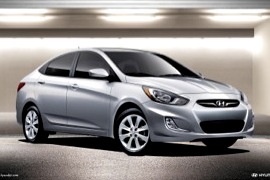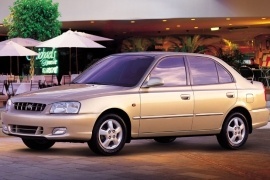
HYUNDAI Accent Sedan
Generations Timeline, Specs and Pictures

The fifth generation of the Hyundai Accent was introduced at the Orange County International Auto Show.
The car’s evolution showed an increase in dimensions and practicality.
The Hyundai Accent stepped-up with more High Strength Steel made by the Hyundai steel factories. Due to intensive use of HSS, less steel material was required but the final result was a 32% stronger body and only 11 kg (22 lbs) more weight added to the unibody construction.
When viewed from some angles, the 2017 Accent looked like a shrunken Sonata. But, despite being smaller than the executive Hyundai sedan, it kept some nice proportions and elegance. Usually, the four-door, small class, vehicles don’t look very well. Their forms are compromised by the difference between the tall greenhouse and the rest of the bodywork. On the fifth generation of the Accent, even the big cascading grille looked good.
The interior was modern and well-equipped for its era. It featured a clean instrument cluster with analog round dials. For the infotainment system, there was a standard 5” TFT display on the center console. A bigger, 7” unit was offered as an option. Also, the backup camera was offered as standard.
For the engine compartment, the 2017 Accent up to four gasoline and three diesel units, depending on the market. The standard transmission was a 6-speed manual, while a 6-speed automatic, a 7-speed dual-clutch and a CVT were offered as an option.

The 2013 Accent continues Hyundai’s mission to defy convention by offering extraordinary value and class-above features to subcompact car shoppers.
Now in its second year of production, Accent adds even more standard equipment and offers new class-above comfort features to satisfy shoppers in this hot segment.
Heated side mirrors, remote keyless entry and air conditioning are now standard on all 2013 Accent trims. Accent SE’s side mirrors have been upgraded with turn signal indicators for an extra level of safety. Shoppers also will find an optional power sunroof on the Accent SE trim.
Accent has been well-received by shoppers. In fact, through the month of May, total Accent sales were up 51% over the same period in 2011. Retail (non-fleet) Accent sales were up an impressive 139% due to a 66.2% reduction in fleet mix. Automotive media and industry experts have also taken notice of Accent’s product success, awarding it various coveted awards and accolades since its reveal in April 2011. Along with two designations from WardsAuto, Accent was the highest rated subcompact sedan by a leading enthusiast magazine, above Chevrolet Sonic, Honda Fit and Toyota Yaris.

By 2006, Hyundai was no longer a stranger on any market, and the Accent was one of its best-selling products.
When it introduced the four-door sedan version, Hyundai aimed to the families that asked for more but couldn’t afford it. It wasn’t a very sophisticated car and, thanks to its affordable price, it wasn’t a burden on the budget. Last but not least, the Korean brand was already known for its reliable products, and that helped its sales department.
The sedan was a simple vehicle built for simple people. It didn’t offer any aggressive stance or ferocious look. Its soft edges and curved surfaces resembled the bio-design era, which was already gone from the market. But its customers didn’t care about that: all they wanted was a user-friendly vehicle, and the sedan was just that.
Inside, the carmaker installed gray upholstery and gray door panels. It was not the best plastic available from Hyundai, but it was stain-resistant and easy to clean. For young families with small kids or toddlers, that was a huge advantage. There was room for two adults in the rear if they were not taller than average, and the trunk was large enough for a weekend trip for a family of two-and-a-half.
Under the hood, Hyundai installed a choice of three engines: two gasoline and a turbo-diesel. They were paired as standard to a 5-speed manual gearbox, while a four-speed automatic transmission was available for the gasoline-powered versions.

Hyundai stepped up its game and introduced the Accent’s second generation’s facelifted version in 2003 as a sedan and hatchback with three or five doors.
The five-door version was designed to serve as a mix between a three-box sedan and a station wagon. It was a good option for those who were looking for a small vehicle to fit in tighter parking spots and still offer a large trunk space. Along with the exterior refresh, the Korean carmaker introduced new and upgraded engines to make the car cleaner and more fuel-efficient.
In a time when most of the carmakers started to sharpen-up the lines on their cars, Hyundai softened the Accent’s lines. The headlights were not as angular-looking, and the former clear edges on its sides were changed to a curved area. Hyundai’s designers managed to make the taillights taller in the rear, but they also made the reversing lights smaller.
Inside, there were no visible changes to the interior, except for the instrument panel design, where the carmaker changed the position for the coolant temperature and fuel level gauge.
Like the non-facelifted version, the 2003 Accent featured a split-folding rear bench seatback that increased the trunk capacity from 321 liters to 859 liters.
Under the hood, Hyundai made an important step and installed a newly developed 1.5-liter turbodiesel engine. Other engine choices included the already known 1.3-liter and, as a full-version, the 1.6-liter unit that provided 105 hp. For the latter, the carmaker offered a 4-speed automatic transmission.

In 2000 the second generation Accent was released on the market and by 2003 it already got one minor facelift when it was also codenamed the LC2.
The sedan would receive another facelift in 2006 while the hatchback continued to sell only in Canada. The car performed much better in unofficial safety tests than previous generations and even pre-facelift models, a sign that the design of the chassis had evolved. It was available with upgraded engines - 84 HP 1.3-liter and 105 HP 1.6-liter - as well as two gearboxes, a 5-speed manual and an optional 4-speed automatic.

Hyundai introduced the second generation of the Accent in 1999.
It was a big improvement over its predecessor and brought the sedan version as an essential sales factor.
Hyundai was still young on the car-market when it introduced the second generation of the Accent. From its previous models, the Korean carmaker understood that it could win a place at the table only if it could offer more features for the same money. The second generation did even more than that.
While the first generation was a bland, rounded car, the second generation featured a grille that looked like a mouth with teeth. The angular headlights and sharp lines made the car look more aggressive. It was available in two body versions with three and five doors hatchback and a sedan with four doors. Hyundai noticed that the small-segment three-box vehicles were highly appreciated in many markets and tried to offer them at a reasonable price.
The interior was heavily improved over its predecessor with better materials and a roomier cabin due to the longer wheelbase. It was not a big difference, but it was the difference between pressed knees and touching knees for the rear passengers. The carmaker installed a standard AC-unit and power-windows at the front for the Accent sedan. For selected markets, such as the north side of Europe and Canada, the Accent was not just a cheap transportation device. It was a car.
For the powertrain, Hyundai installed a 1.3-liter gasoline engine for the base level and a 1.5-liter unit. The latter was available with an automatic transmission as well.























































